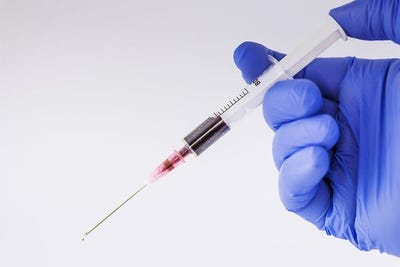How a pH Indicator Made Blood Typing Faster, Cheaper
March 17, 2017
Chinese researchers believe their new, paper-based test could be used in war zones and remote locations
Nancy Crotti

Chinese researchers have developed a speedy paper blood-type test using a common pH indicator.
The researchers used antibodies immobilized on paper test strips to separate red blood cells and plasma from small volumes (100 ?l) of whole, uncentrifuged blood samples. The pH indicator, bromocresol green dye, revealed color changes that indicatedA and/or B antigens on red blood cells (forward grouping) within 30 seconds, and the attachment of red blood cells to anti-A and/or anti-B antibodies in plasma within 2 minutes. The test could also perform Rhesus and rare-blood typing.
The test strip turned teal if a blood group antigen was present in a sample and brown if not. The researchers developed a machine-learning method to classify the spectral plots corresponding to the dye-based color changes, allowing them to reproduce the automatic blood grouping. The dye-assisted paper assay's results were comparable to the classical gel-card assays in grouping 3550 human blood samples, according to the study, which was published in Science Translational Medicine.
Blood type matching is important for pregnancy, blood transfusion, and bone marrow transplantation. This test's rapid turnaround time could make it ideal for war zones, remote areas, and during emergencies, according to the authors.
"In traditional approaches for blood grouping, we cannot perform the forward and reverse ABO grouping simultaneously, owing to the quite opposite targets," lead researcher Hong Zhang told Qmed in an email. "There have some reports about paper-based blood grouping assay before, which identified blood group by observing the color change (red or white) induced by the aggregated antigen-antibody complex. There have (been) some problems, including lack of quality control, (making it) easy to misjudge."
Although bromocresol green dye is widely available the team is studying other dyes to use with the test. The researchers are based at Southwest Hospital, Third Military Medical University in Chongqing, China.
The blood-typing test is among the latest inexpensive, rapid tests that researchers have developed in recent years. U.S. researchers from several universities developed paper-based rapid tests to detect the ebola virus during a 2014 outbreak, and another to spot the zika virus in 2016.
That team, led by James Collins, a professor of medical engineering and science at MIT, was able to demonstrate that they could develop synthetic gene networks embedded onto paper that could be programmed to detect specific genetic sequences that cause the paper to change color.
Nancy Crotti is a contributor to Qmed.
[Image courtesy of Frolicsomepl/Pixabay]
About the Author(s)
You May Also Like

.png?width=300&auto=webp&quality=80&disable=upscale)
